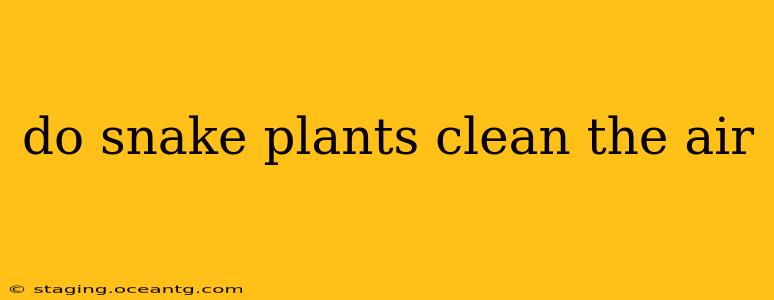Do Snake Plants Clean the Air? A Deep Dive into the Science
The idea that snake plants ( Sansevieria trifasciata, also known as Mother-in-Law's Tongue) clean the air is a popular one, often touted in home décor and gardening circles. But does the science back up this claim? The short answer is: it's complicated. While snake plants do contribute to air purification, the effect is much smaller and more nuanced than often portrayed.
Let's delve into the research and explore the truth behind this popular belief.
What is the NASA Clean Air Study?
The most frequently cited source for the air-purifying properties of snake plants is the NASA Clean Air Study. This 1989 study investigated the use of plants to remove volatile organic compounds (VOCs) from spacecraft environments. While the study demonstrated that some plants could effectively remove certain VOCs under specific controlled laboratory conditions, it's crucial to understand its limitations.
Key Limitations of the NASA Study:
- Controlled Environment: The study was conducted in sealed, artificial environments, vastly different from the air circulation and complexities of a typical home.
- Scale: The scale of the experiment (relatively small chambers) doesn't directly translate to the much larger volume of air in a typical home. You would need a significantly larger number of plants to achieve a noticeable effect.
- VOC Concentration: The VOC concentrations used in the study were much higher than those typically found in homes.
- Limited Plant Selection: The study focused on a limited number of plant species.
How Do Snake Plants (Potentially) Clean the Air?
Snake plants, like many other plants, perform photosynthesis. During this process, they absorb carbon dioxide (CO2) and release oxygen (O2). Additionally, they engage in a process called transpiration, where they release water vapor into the air, potentially increasing humidity. Furthermore, some studies suggest they can absorb small amounts of VOCs, including formaldehyde and benzene.
However, the amount of these pollutants removed by a single snake plant is minimal and unlikely to significantly impact air quality in a typical home.
Are Snake Plants Beneficial for Air Quality in Homes?
While the dramatic claims of snake plants dramatically improving air quality are largely unfounded, they do offer some potential benefits:
- Improved Mood and Well-being: The presence of plants can create a more calming and aesthetically pleasing environment, positively impacting mental well-being.
- Increased Humidity: Transpiration can slightly increase humidity, potentially beneficial in dry climates.
- Aesthetic Appeal: Snake plants are visually appealing and add a touch of greenery to any room.
- Removal of Some VOCs: While the effect is minimal in a home setting, it does contribute to overall air quality, albeit to a negligible degree.
How Many Snake Plants Do I Need to Clean the Air?
There's no magic number. The NASA Clean Air Study doesn't provide a guide for how many plants would be needed to significantly improve air quality in a home. To significantly impact VOC levels in a home, you would likely need an impractical number of plants.
What are Better Ways to Improve Indoor Air Quality?
Focusing on improved ventilation is far more effective than relying solely on plants. Consider:
- Regular airing out of rooms: Opening windows to allow fresh air circulation.
- Using air purifiers with HEPA filters: These are far more effective at removing VOCs and other pollutants.
- Reducing sources of indoor pollution: Avoiding harsh cleaning chemicals, smoking indoors, and using eco-friendly materials.
In conclusion, while snake plants are attractive and offer some minor benefits, they aren't a magical solution for cleaning the air in your home. Prioritizing good ventilation and using effective air purifiers will deliver more significant results for improved air quality.
